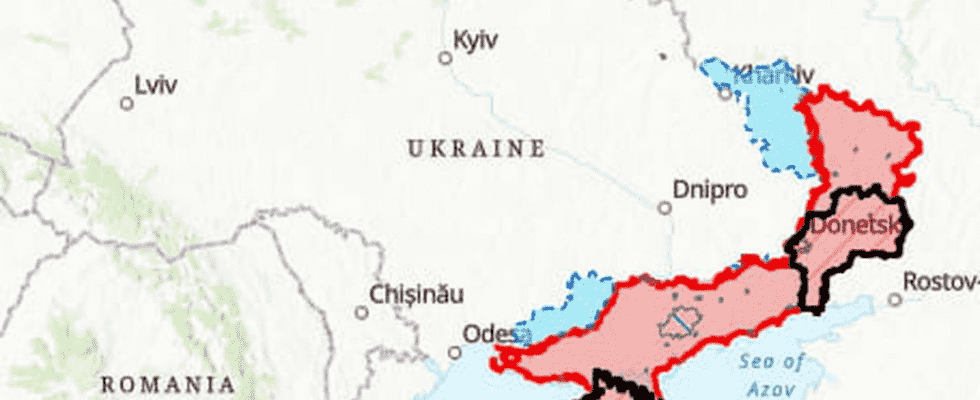UKRAINE MAP. By trying at all costs to conquer the cities of Soledar and Bakhmout in the east of the country, Russia seeks to turn the tide of the war after humiliating reverses in 2022. Find several maps tracing the evolution of the war in Ukraine .
[Mis à jour le 13 janvier 2023 à 17h18] The war in Ukraine has now been going on for more than ten months. As a reminder, the conflict started on February 24, 2022, when Vladimir Putin, the Russian president, ordered the invasion of the country as part of his “special military operation”. The conflict is now concentrated around the towns of Soledar and Bakhmout, two towns in eastern Ukraine that Moscow is trying to conquer at all costs, in order to reverse the course of the war. Russia suffered humiliating setbacks in 2022, being forced to withdraw its armed forces from Kharkiv (in the northeast) in September, but also from the city of Kherson (in the south) in November, following counter-offensives victorious over the forces of kyiv.
The Russian army claimed on Friday, January 13, 2023, that it had completely conquered the city of Soledar, located in Donetsk Oblast. “The liberation of the town of Soledar, which is important for the continuation of offensive operations” in the Donetsk region was completed on January 12 in the evening, the Russian Defense Ministry said in a statement. Information that has been denied by kyiv. Serhiy Tcherevaty, spokesman for the Eastern District of the Ukrainian Armed Forces, has indeed indicated that “fights are still going on”, in a comment to the Ukrainian media RBK-Ukraine. If the capture of Soledar by the Russians were to be proven, it would constitute a first military victory for Moscow since months of fighting.
Moscow, which changed its strategy by placing General Valéri Guerassimov as commander-in-chief of the Russian offensive in Ukraine on January 11. With the chief of staff of the Russian army to lead his offensive, Vladimir Putin could prepare a new wave of mobilization in his country. Quoted by the British daily The Guardian on 6th January last, Vadym Skibitsky, deputy head of Ukrainian military intelligence, affirmed that Moscow could in the next few days call up 500,000 additional men to take part in the war effort. With these new arrivals, the number of soldiers in Ukraine would rise to one million. If this information was denied by the Russian authorities, it was confirmed by the military intelligence of Estonia, as indicated The world. You can consult below several maps retracing the evolution of the war in Ukraine, in order to follow the conflict in real time and as best as possible.
Map of the war in Ukraine in real time
About 3000 kilometers from France, difficult to understand everything about the real-time evolution of the conflict. Thus, maps play a major role in allowing the general public to know, at a glance, the day-to-day situation in Ukraine. One in particular provides one of the best daily explanations: the one developed by the Institute for the Study of Waran American study group producing maps and reports on the various conflicts in the world.
The map (to be found below), clear, does not detail the places of the fighting between the Ukrainian and Russian armies, but updates in real time the advance of Russia (red zone), the zones in which Russia claims to have control (yellow), the territories on which Ukraine claimed to have launched a counter-offensive (blue). The black areas correspond to the territories already controlled by the Russians since 2014 (Crimea in the south, part of Donbass in the east).
Other maps on the war in Ukraine
Map in French on the war in Ukraine:
Beyond the Institute for the study of war, many other organizations offer daily or weekly maps on the evolution of the war in Ukraine. This is particularly the case with the French Ministry of Defence, which offers regular situation updates (to be found here). Moreover, The world offers a weekly follow-up with a menu that changes every week.
On Twitter, the maps and situation reports of the historian and former soldier Michel Goya, who became a columnist for BFMTV, are among the most complete. These documents, based on War Mapper maps, are also available on his blog. Abroad, the sites of the New York Times and the Washington Post, the two leading American media, also offer up-to-date maps.
Foreign maps on the war in Ukraine:
One of the most valuable documents currently available online is the map drawn up by Liveuamap.coman independent Ukrainian platform that compiles and cross-checks information from media sources and social media and allows you to view, in real time or almost, the clashes and strikes that follow one another in the country.
Another interactive map published on MapHub allows to visualize the attacks of Russia and the acts of defense of Ukraine since the beginning of the conflict. The tool, which lists hundreds of events to date, is overseen by the Center for Information Resilience (CIR), an independent UK-based not-for-profit company that is also dedicated to identifying, tackling and exposing influence operations. The CIR aims to “raise awareness of the threat that influence operations, including disinformation, pose to democracy and objective truth, and to help counter them”.
The UK Ministry of Defense also delivers very regular reports on the situation in Ukraine. In addition to the “Intelligence updates” (updates of information on the ground) delivered on his Twitter accountthere are also maps summarizing the day-to-day situation.
On the side of the foreign media, the Kyiv Independenta newspaper from the Ukrainian capital, regularly reports, as does the BBCin the United Kingdom, which also has a page allowing you to follow the fighting in Ukraine, just like the FinancialTimes. So many sources that provide information on the evolution of the war in Ukraine.
